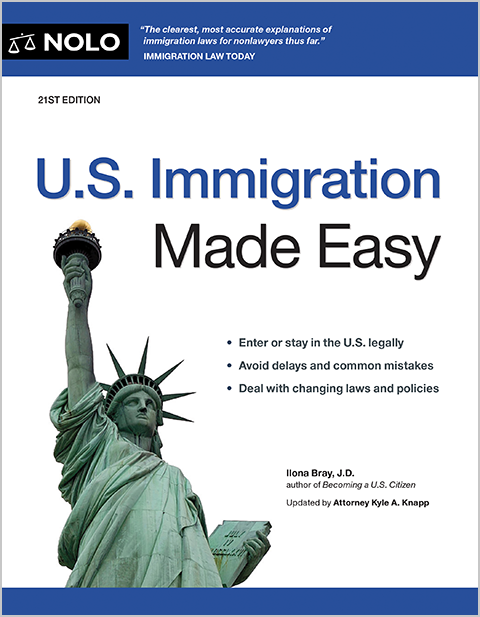Depending on the reason you were ordered deported from the United States, you will have to wait a set amount of time (a minimum of five years) before trying to return.
If you were ordered removed (or deported) from the United States, you cannot simply turn around and come back. By the legal terms of your removal, you will be expected to remain outside of the country for a set number of years: usually either 5, 10, or 20. It's even possible that you will not be allowed to return to the United States at all.
How long you'll have to wait and whether you'll be allowed to return to the United States depends on the exact reason you were deported: for example for a crime or for multiple illegal entries. We'll describe the details below, and alert you to any possibilities for requesting U.S. reentry.
Were You Truly Ordered Removed From the United States?
First, it's important to know whether or not an Immigration Judge (IJ) actually issued a final order of removal against you: particularly if you were ever told to go to immigration court but you don't know or can't remember whether you went or what happened there. Some of the possibilities include that the IJ:
- ordered you removed (deported) because you didn't show up for your court hearing
- ordered you removed (deported) at the end of your court hearing, or
- instead of ordering you deported at the end of your hearing, granted you "voluntary departure," which allowed you to leave the U.S. before a set date without facing the legal consequences of a removal order.
If you were granted voluntary departure but failed to leave by the appointed date, the grant automatically converted to an order of removal. See Voluntary Departure: What Happens If You Don't Leave the United States?.
Also realize that even if you voluntarily departed the United States on time, you could still be inadmissible for a number of years, depending on how much unlawful presence you accrued while you were in the United States. To learn more, see Consequences of Unlawful Presence in the U.S.—Three and Ten Year Time Bars.
To check whether the IJ issued an order of removal in your case, call the Immigration Court customer service line at 1-800-898-7180 (if you're in the U.S.) and follow the electronic prompts.
What Happens When You Get Deported?
At some point after you're ordered removed, you will receive from the U.S. government what's known as a "bag and baggage" letter. It will be mailed to you at the address you gave the immigration court. This letter will give you a date and place to which you report for your trip out of the country, and how much baggage you can bring with you. The U.S. government arranges the actual transport. For more information, see If the Immigration Judge Orders Me Deported, What's Next?.
If You Get Deported, Can You Come Back to the U.S.?
The expectation after you're deported from the U.S. is that you will remain outside for a number of years, a minimum of five (discussed further below). Nevertheless, there exist "waivers" you could potentially apply for, allowing you to seek U.S. entry before you've waited the requisite amount of time.
And once the required time has past, you are, in most situations, free to apply for a new visa or green card. But U.S. immigration officials will of course take a close look at why you were deported and whether that separately impacts your ability to qualify for a U.S. visa or green card. Someone who has committed an extremely serious crime, for example, and was deported as a result, will have difficulty ever persuading U.S. immigration officials to approve them for U.S. entry.
After Removal, How Many Years Must You Wait to Apply to Reenter the United States?
If you do, in fact, have a deportation or removal order in your immigration file, it's possible that you aren't allowed to apply to enter the U.S. for 5, 10, or 20 years. The applicable law comes from Section 212 of the Immigration and Nationality Act (I.N.A.). Here's a quick summary:
Which Deportees Face a Five-Year Ban on Reentry
If you were summarily removed or deported upon arrival at a U.S. port of entry because you were found inadmissible, or if you came to the United States but were immediately put into removal proceedings and then removed or deported, you might be ineligible to return to the U.S. for five years. The five-year ban also applies if you failed to show up for your removal hearing in the United States.
Which Deportees Face a Ten-Year Ban on Reentry
If an IJ issued a removal order at the conclusion of your removal hearing in Immigration Court, you may not return to the United States for 10 years after your removal or departure.
Which Deportees Face a Twenty-Year Ban
If you were convicted of an aggravated felony or have received more than one order of removal, you are barred from returning to the U.S. for 20 years. And if you entered the U.S. without permission after having been removed, or illegally reentered the U.S. after having previously been in the U.S. unlawfully for more than 1 year, you are likely barred from entering the United States for 20 years or permanently (in that you'll need special consent to return).
Options for Returning to the U.S. After Removal
If you were ordered removed from the U.S., there are limited options that might enable you to return legally.
First, you will need a valid basis for applying for a U.S. visa or green card. One cannot just turn back the clock and get one's old immigration status (if any) back. Sponsorship by an employer or a spouse or other U.S.-citizen or permanent resident family member are the most common possibilities for becoming green-card eligible, for example. You might also, depending on your skills and plans, qualify for a nonimmigrant visa that would allow you a temporary stay, such as a B-2 visitor visa or an F-1 student visa.
Before you can apply for any of these forms of U.S. entry however, however, you would need to apply for a waiver that could "forgive" your prior removal order and give you permission to reenter the U.S. with the visa or green card. To learn more about applying for permission to enter the U.S. after deportation, see After Removal: Possibilities for Reentry to the U.S.
If you have a 20-year ban against you, however, you must wait until you have been outside the U.S. for at least 10 years before so much as applying for a waiver.
How an Immigration Attorney Can Help
Returning to the United States after removal is a complicated and difficult process. It's best to seek legal assistance as soon as possible, to discuss your case and the options available to you. Many attorneys can work with you remotely even if you are not physically present in the United States.
Talk to a Lawyer
Need a lawyer? Start here.
How it Works
- Briefly tell us about your case
- Provide your contact information
- Choose attorneys to contact you
- Briefly tell us about your case
- Provide your contact information
- Choose attorneys to contact you

